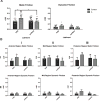Reduction of friction by recombinant human proteoglycan 4 in IL-1α stimulated bovine cartilage explants
- PMID: 27411036
- PMCID: PMC5957283
- DOI: 10.1002/jor.23367
Reduction of friction by recombinant human proteoglycan 4 in IL-1α stimulated bovine cartilage explants
Abstract
A boundary lubricant attaches and protects sliding bearing surfaces by preventing interlocking asperity-asperity contact. Proteoglycan-4 (PRG4) is a boundary lubricant found in the synovial fluid that provides chondroprotection to articular surfaces. Inflammation of the diarthrodial joint modulates local PRG4 concentration. Thus, we measured the effects of inflammation, with Interleukin-1α (IL-1α) incubation, upon boundary lubrication and PRG4 expression in bovine cartilage explants. We further aimed to determine whether the addition of exogenous human recombinant PRG4 (rhPRG4) could mitigate the effects of inflammation on boundary lubrication and PRG4 expression in vitro. Cartilage explants, following a 7 day incubation with IL-1α, were tested in a disc-on-disc configuration using either rhPRG4 or saline (PBS control) as a lubricant. Following mechanical testing, explants were studied immunohistochemically or underwent RNA extraction for real-time polymerase chain reaction (RT-PCR). We found that static coefficient of friction (COF) significantly decreased to 0.14 ± 0.065 from 0.21 ± 0.059 (p = 0.014) in IL-1α stimulated explants lubricated with rhPRG4, as compared to PBS. PRG4 expression was significantly up regulated from 30.8 ± 19 copies in control explants lubricated with PBS to 3330 ± 1760 copies in control explants lubricated with rhPRG4 (p < 0.001). Explants stimulated with IL-1α displayed no increase in PRG4 expression upon lubrication with rhPRG4, but with PBS as the lubricant, IL-1α stimulation significantly increased PRG4 expression compared to the control condition from 30.8 ± 19 copies to 401 ± 340 copies (p = 0.015). Overall, these data suggest that exogenous rhPRG4 may provide a therapeutic option for reducing friction in transient inflammatory conditions and increasing PRG4 expression. © 2017 Orthopaedic Research Society. Published by Wiley Periodicals, Inc. J Orthop Res 35:580-589, 2017.
Keywords: Interleukin-1; PRG4; articular cartilage; biomechanics; lubricin; post-traumatic osteoarthritis; tribology, friction.
© 2017 Orthopaedic Research Society. Published by Wiley Periodicals, Inc.
Conflict of interest statement
All other authors have no conflicts of interest.
Figures





Similar articles
-
Full-Length Recombinant Human Proteoglycan 4 Interacts with Hyaluronan to Provide Cartilage Boundary Lubrication.Ann Biomed Eng. 2016 Apr;44(4):1128-37. doi: 10.1007/s10439-015-1390-8. Epub 2015 Jul 21. Ann Biomed Eng. 2016. PMID: 26194040
-
Intra-articular Recombinant Human Proteoglycan 4 Mitigates Cartilage Damage After Destabilization of the Medial Meniscus in the Yucatan Minipig.Am J Sports Med. 2017 Jun;45(7):1512-1521. doi: 10.1177/0363546516686965. Epub 2017 Jan 27. Am J Sports Med. 2017. PMID: 28129516 Free PMC article.
-
Effect of counterface on cartilage boundary lubricating ability by proteoglycan 4 and hyaluronan: Cartilage-glass versus cartilage-cartilage.J Orthop Res. 2018 Nov;36(11):2923-2931. doi: 10.1002/jor.24104. Epub 2018 Jul 23. J Orthop Res. 2018. PMID: 29978918
-
The biology of lubricin: near frictionless joint motion.Matrix Biol. 2014 Oct;39:17-24. doi: 10.1016/j.matbio.2014.08.008. Epub 2014 Aug 27. Matrix Biol. 2014. PMID: 25172828 Review.
-
Prg4 and Osteoarthritis: Functions, Regulatory Factors, and Treatment Strategies.Biomedicines. 2025 Mar 12;13(3):693. doi: 10.3390/biomedicines13030693. Biomedicines. 2025. PMID: 40149669 Free PMC article. Review.
Cited by
-
Arthroscopic irrigation of the bovine stifle joint increases cartilage surface friction and decreases superficial zone lubricin.J Biomech. 2016 Sep 6;49(13):3106-3110. doi: 10.1016/j.jbiomech.2016.07.024. Epub 2016 Jul 27. J Biomech. 2016. PMID: 27511596 Free PMC article.
-
Friction-Induced Mitochondrial Dysregulation Contributes to Joint Deterioration in Prg4 Knockout Mice.Int J Mol Sci. 2017 Jun 11;18(6):1252. doi: 10.3390/ijms18061252. Int J Mol Sci. 2017. PMID: 28604608 Free PMC article.
-
Interactions and Trends of Interleukins, PAI-1, CRP, and TNF-α in Inflammatory Responses during the Perioperative Period of Joint Arthroplasty: Implications for Pain Management-A Narrative Review.J Pers Med. 2024 May 17;14(5):537. doi: 10.3390/jpm14050537. J Pers Med. 2024. PMID: 38793119 Free PMC article. Review.
-
The autocrine role of proteoglycan-4 (PRG4) in modulating osteoarthritic synoviocyte proliferation and expression of matrix degrading enzymes.Arthritis Res Ther. 2017 May 8;19(1):89. doi: 10.1186/s13075-017-1301-5. Arthritis Res Ther. 2017. PMID: 28482921 Free PMC article.
-
Mechanical Wear of Degraded Articular Cartilage.Ann Biomed Eng. 2025 Apr;53(4):956-965. doi: 10.1007/s10439-025-03680-8. Epub 2025 Jan 25. Ann Biomed Eng. 2025. PMID: 39863807
References
-
- Murphy L, Helmick CG. The impact of osteoarthritis in the United States: a population-health perspective: A population-based review of the fourth most common cause of hospitalization in U.S. adults. Orthopedic nursing. 2012;31:85–91. - PubMed
-
- Gabriel SE, Crowson CS, Campion ME, et al. Direct medical costs unique to people with arthritis. The Journal of rheumatology. 1997;24:719–725. - PubMed
-
- Brown TD, Johnston RC, Saltzman CL, et al. Posttraumatic osteoarthritis: a first estimate of incidence, prevalence, and burden of disease. Journal of orthopaedic trauma. 2006;20:739–744. - PubMed
-
- Zhang LZ, Z H, Jiang Y, Tu YH, Jiang PH, Yang AL. Mechanical and biologic link between cartilage and subchondral bone in osteoarthritis. Arthritis Care Res. 2012;64:960–967. - PubMed
Publication types
MeSH terms
Substances
Grants and funding
LinkOut - more resources
Full Text Sources
Other Literature Sources
Medical
Miscellaneous

